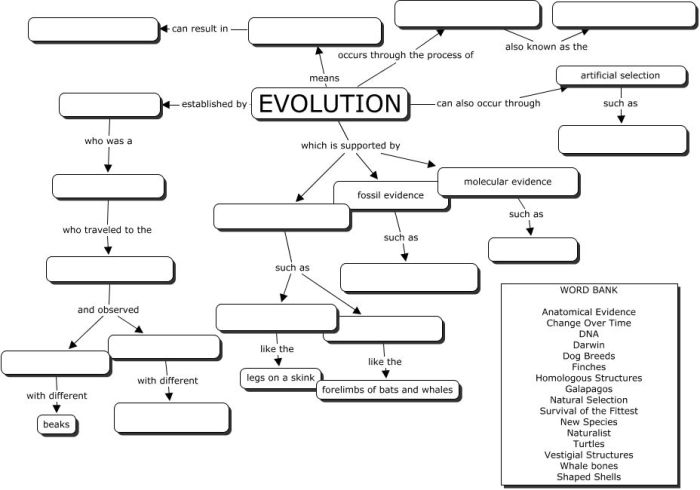Embarking on a journey through the fascinating realm of evolution, we present mechanisms of evolution worksheet answers, a comprehensive guide to understanding the intricate processes that shape the diversity of life on Earth. This exploration delves into the fundamental principles that govern the transformation of species over time, shedding light on the driving forces behind evolutionary change.
Throughout this discourse, we will unravel the mechanisms of natural selection, genetic drift, gene flow, mutation, and non-random mating, providing concrete examples and insightful explanations to illuminate their profound impact on the evolution of life forms.
Natural Selection

Natural selection is the process by which organisms that are better adapted to their environment are more likely to survive and reproduce, passing on their traits to their offspring. Over time, this can lead to significant changes in a population’s genetic makeup and physical characteristics.
One of the key factors that drives natural selection is genetic variation. This variation arises from mutations, which are random changes in an organism’s DNA. These mutations can be beneficial, harmful, or neutral. If a mutation is beneficial, it will increase an organism’s chances of survival and reproduction.
If a mutation is harmful, it will decrease an organism’s chances of survival and reproduction. Neutral mutations have no effect on an organism’s fitness.
Examples of Natural Selection, Mechanisms of evolution worksheet answers
- In peppered moths, the dark-colored form became more common during the Industrial Revolution because it was better camouflaged against the soot-covered trees.
- In antibiotic-resistant bacteria, the bacteria that are resistant to antibiotics are more likely to survive and reproduce, passing on their resistance genes to their offspring.
- In Darwin’s finches, the different species of finches have evolved different beak shapes that are adapted to their specific food sources.
Genetic Drift
Genetic drift is the random change in the frequency of alleles in a population. This can occur due to a number of factors, such as population bottlenecks, founder effects, and random sampling error.
Population bottlenecks occur when a population is drastically reduced in size, often due to a natural disaster or other catastrophic event. This can lead to the loss of genetic diversity, as some alleles may be lost from the population entirely.
Founder effects occur when a new population is established by a small group of individuals. This can lead to the population having a different genetic makeup than the original population, as the founding individuals may not carry all of the alleles that were present in the original population.
Random sampling error can occur when a sample of individuals is taken from a population. This sample may not be representative of the population as a whole, and as a result, the frequency of alleles in the sample may not be the same as the frequency of alleles in the population.
Examples of Genetic Drift
- In the cheetah population, all cheetahs are descended from a small group of individuals that survived a population bottleneck around 10,000 years ago. This has led to the cheetah population having very low genetic diversity.
- In the Amish population, the founder effect has led to the population having a high frequency of certain genetic disorders, such as Ellis-van Creveld syndrome.
- In the study of human evolution, random sampling error has led to some populations having a different frequency of alleles than other populations, even though the populations are closely related.
Gene Flow
Gene flow is the movement of alleles from one population to another. This can occur through a variety of mechanisms, such as migration, mating, and the introduction of new individuals into a population.
Migration is the movement of individuals from one population to another. This can lead to the introduction of new alleles into the recipient population, which can increase genetic diversity.
Mating is the process by which two individuals exchange genetic material. This can lead to the introduction of new alleles into a population, as well as the recombination of existing alleles.
The introduction of new individuals into a population can also lead to the introduction of new alleles. This can occur through the introduction of new species into an ecosystem, or through the release of captive-bred individuals into a wild population.
Examples of Gene Flow
- In the Galapagos Islands, the different species of Darwin’s finches have evolved different beak shapes due to gene flow between the islands.
- In the human population, the migration of people from one continent to another has led to the introduction of new alleles into different populations.
- In the study of agriculture, the introduction of new crop varieties into a region can lead to the introduction of new alleles into the local population of crops.
Essential FAQs: Mechanisms Of Evolution Worksheet Answers
What is the significance of genetic variation in natural selection?
Genetic variation provides the raw material upon which natural selection acts. It introduces diversity within a population, allowing for individuals with advantageous traits to survive and reproduce more successfully.
How does gene flow influence the genetic makeup of populations?
Gene flow involves the exchange of genetic material between populations. It can introduce new alleles into a population, increasing genetic diversity and potentially altering the trajectory of evolution.
What are the different types of non-random mating?
Non-random mating occurs when individuals mate with each other based on specific traits or preferences. Types include assortative mating, where individuals with similar traits mate, and disassortative mating, where individuals with different traits mate.